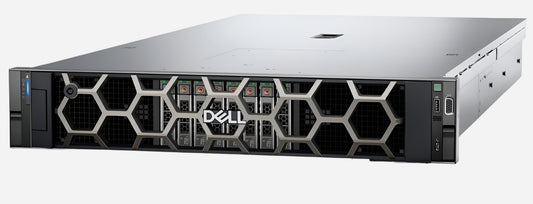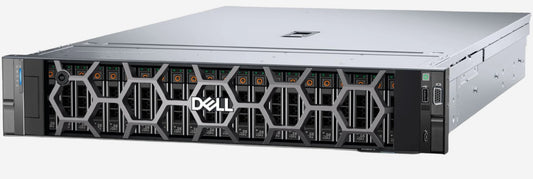
Dell PowerEdge R760 Review
OLEKSANDR SYZOVShare
Dell PowerEdge R760 Review
The Dell PowerEdge R760 is a 2U rackmount server that supports two fourth-generation Intel Xeon processors and up to 24 NVMe disks, including bases that support the new EDSFF E3.S SSDs. Incidentally, the E3.S SSDs are the only Gen5 drive form factor supported on this base; U.2 bays are Gen4 only. Support for the new drives makes configuring the disk subsystem even more important when configuring the PowerEdge for specific use cases.
Dell PowerEdge R760 Specifications
PowerEdge R760 is essentially a 2U version of the 1U PowerEdge R660 server we've already reviewed. Both servers support two fourth-generation Intel Xeon "Sapphire Rapids" processors each with a maximum configuration of up to 56 cores/128 threads per CPU and up to 8TB of RAM in 32 DIMM slots. These servers are designed for mixed workloads, databases and VDI.
When it comes to storage, twice the height makes the R760 roomier than the R660; it supports the following configurations (with up to 24 NVMe drives):
12 x 3.5-inch
8 x 2.5-inch
16 x 2.5-inch
24 x 2.5-inch
2 x 2.5-inch or 4 x 2.5-inch (rear)
The 1U R660 server supports a maximum of 10 x 2.5-inch disks, plus 2 2.5-inch disks at the rear. We took a detailed look at the E3.S backplane in the R660. E3.S disks will soon be available in the PowerEdge R760 as well.
I will note that the R760 can be configured with direct storage access, as in this review model, or with Dell's new PERC 12 RAID card that supports NVMe HWRAID (up to 16 HWRAID + 8 direct NVMe connections). As noted earlier, there are a lot of disk subsystem decisions to make when configuring Dell's new PowerEdge mainstream servers.
The R760 also supports more PCIe slots than the PowerEdge R660: four Gen5 and eight Gen4 versus two Gen5 and three Gen4 in the R660. The R760 supports dual GPUs (up to 350 watts); the R660 is limited to two single cards up to 75 watts.
Dell doesn't offer exact counterparts to the R760 and R660 on AMD EPYC processors; the closest servers are the 2U PowerEdge R7625 and 1U PowerEdge R6625.
Dell PowerEdge R760 design and construction
The PowerEdge R760 is a 2U rackmount server with a height of 86.8 mm and a width of 482 mm. Its depth can be 772.13 mm with bezel or, as shown below, 758.29 mm without bezel. 24 2.5-inch drive bays occupy the entire front panel.

The drives are easily removed by pressing the locking buttons and then released from the holders. Each drive has LED status and activity indicators. The tongue in the lower right corner with the name is a service label that slides out for easy server identification.
On the rear panel are Ethernet ports for remote iDRAC management, USB 2.0, USB 3.0, and VGA. Our server does not have an additional Serial port.
Our R760 also has NVMe BOSS boot drives on the rear panel. These are hot-accessible (as pictured below) and have a built-in RAID controller.

Let's move on to the inside. Cooling ducts and risers (risers - extensions for PCIe connectors) almost completely cover the PCB. The air supply comes from six fans with a diameter of 4 cm.
Another angle: the ducting has been removed, but the raisers are still in place.
The two Xeon processors have massive heatsinks with special extensions that connect them closely to the fans. Each processor takes over 16 DIMM slots. When fully equipped, this server supports up to 8 Tbytes of RAM. The Dell PowerEdge R760 supports up to eight PCIe slots.Another angle: the ducting has been removed, but the raisers remain in place.

The Dell PowerEdge R760 has two slots for hot-swappable power supplies (there is redundancy functionality when enough power is available). Power ranges from 700W to 2800W and is rated 80 Plus Platinum or Titanium.
The server presented in the review is air-cooled. However, some R760 server configurations can use direct liquid cooling. Some processors, such as the Intel 8470Q, are only available with Direct Liquid Cooling. Dell has a number of certified partners that offer a variety of liquid cooling options if your environment requires it.
Dell PowerEdge R760 remote management
The PowerEdge R760 has a Dell iDRAC remote management controller.
The main panel displays the overall system status, recent logs, and a task summary.

The System section contains many categories, each with a status indicator. The Power section displays the status of each power supply and the history of power consumption.

This is followed by the “Memory” section, which displays the status of each slot and details the type of memory installed.

Здесь находится раздел технического обслуживания; в журнале жизненного цикла “Lifecycle Log” отображаются основные события.

The “SupportAssist” section in “Maintenance” allows you to track maintenance requests. Very cool feature.

The last is the Storage section, which displays configuration details and an overall summary as shown below.

Dell PowerEdge R760 Performance
Our review server Dell PowerEdge R760 has the following configuration:
Two Intel Xeon Gold 6430 processors (32 cores/64 threads each, base frequency 1.9 GHz, Turbo 3.4 GHz, 60MB cache, TDP 270W)
1 TB of DDR5 memory
Microsoft Windows Server 2019
NVIDIA A2 or T4 graphics gas pedal (for GPU tests)
Like most 2U rackmount servers with dual processors, the PowerEdge R760 has an almost infinite number of options (see Dell's website). As mentioned, we will focus on CPU and GPU performance in this review, as we are dedicating a separate review to storage performance.
Our configuration is not the maximum for this platform; it can be equipped with two 56-core processors and 8 Tbytes of RAM. There are dozens of processor options in total: Xeon Silver, Gold, Platinum, and Max class processors are available.
To demonstrate the versatility of the configurations available in the PowerEdge R660 and R760 lines, we'll compare them.
The R660 which had the following configuration:
2 x Intel Xeon Platinum 8452Y processors
512 GB DDR5
The Xeon Platinum 8452Y is a 36-core processor, but it has lower base and turbo frequencies (2.0GHz and 3.2GHz). It shouldn't be much different in performance than the Xeon Gold 6430 in our PowerEdge R760, but there may be other reasons to upgrade to Platinum chips. (The Platinum 8452Y's recommended price is almost double that of the Gold 6430).
HWBOT x265
The HWBOT x265 benchmark from hwbot.org measures system performance when rendering 1080P or 4K video using the x265/HEVC codec. It is designed with modern instruction sets in mind and optimized for multi-threading for competitive benchmarks. There is little difference between the two servers head-to-head.
|
HWBot x256 |
Dell PowerEdge R760 (2 x Xeon Gold 6430) |
Dell PowerEdge R660 (2 x Xeon Platinum 8452Y) |
|
3x Overkill (4K) |
78,222 |
74,338 |
y-cruncher
y-cruncher is a multi-threaded and scalable program that can calculate the number of Pi and other mathematical constants to trillions of digits. Since its launch in 2009, it has become a popular performance and stress testing tool among hardware enthusiasts and hobbyists. Here again, we see that the Xeon Gold chips in the PowerEdge R760 have a slight performance advantage.
|
y-cruncher (общее время вычислений) |
Dell PowerEdge R760 (2x Xeon Gold 6430) |
Dell PowerEdge R660 (2x Xeon Platinum 8452Y) |
|
1 миллиардов цифр |
7.306 секунд |
8.294 секунд |
|
10 миллиардов цифр |
91.435 секунд |
92.779 секунд |
Geekbench 6 CPU
Geekbench is a cross-platform benchmark. We use a CPU performance benchmark that has multiple workloads to simulate real-world tasks and applications. We only have results for the PowerEdge R760.
|
Multi-Core Score: |
12,971 |
|
Single-Core Score: |
1,410 |
Blender
The Blender benchmark measures CPU or GPU performance in 3D rendering by rendering a 3D scene in the Blender program. It produces a result that can be used to compare the performance of different systems and components. Performance is given in samples per minute.
|
Blender (CPU) |
Dell PowerEdge R760 (2x Xeon Gold 6430) |
Dell PowerEdge R660 (2x Xeon Platinum 8452Y) |
|
Monster |
576.928413 |
641.524059 |
|
Junkshop |
376.557690 |
398.081932 |
|
Classroom |
281.536442 |
313.184991 |
We also conducted testing after installing the NVIDIA A2 GPU in the PowerEdge R760. However, we do not have data for the PowerEdge R660.
|
Blender (NVIDIA A2) |
|
|
Monster: |
479.238127 |
|
Junkshop: |
302.355378 |
|
Classroom: |
248.540754 |
UL Procyon AI Inference (CPU)
The UL Procyon AI Inference benchmark suite tests the performance of various artificial intelligence systems using modern neural networks. The tests are executed on the CPU only. Below are the average computation execution times; the overall result is in the last row. We ran this test only on the PowerEdge R760.
|
MobileNet V3: |
3.05 |
|
ResNet 50: |
6.79 |
|
Inception V4: |
20.55 |
|
DeepLab V3: |
31.27 |
|
YOLO V3: |
32.58 |
|
REAL-ESRGAN: |
1498.36 |
|
Общая оценка: |
169 |
V-Ray
V-Ray is an image rendering benchmark. We run it on the CPU and also after installing the NVIDIA T4 GPU.
|
V-Ray |
Dell PowerEdge R760 (2x Xeon Gold 6430) |
Dell PowerEdge R660 (2x Xeon Platinum 8452Y) |
|
CPU Only: |
59,628 |
64,296 |
|
CUDA (NVIDIA Tesla T4) |
554 |
564 |
|
RTX (NVIDIA Tesla T4) |
760 |
N/A |
Conclusion
Dell's PowerEdge R lineup is highly versatile, offering configurations for mixed workloads, VDI, database and general purpose. We've already reviewed the 1U PowerEdge R660 favorably, so we had equally high expectations for the 2U PowerEdge R760, and they were met.
The extra height (+1U) gives the PowerEdge R760 more expansion and storage options than the R660, which makes sense. Otherwise, both servers have the same processors and memory. Fourth-generation Intel Xeon chips provide up to 56 cores per socket, allowing the PowerEdge R760 to support up to 112 cores and 224 threads, as well as up to 8 Tbytes of RAM. And if you're concerned about system overheating (or have already invested in a liquid cooling system), the R760 supports direct liquid cooling (DLC) in some configurations.
The extra height allows for double-width GPUs in the R760 (although there is also a Dell PowerEdge R760xa model with a very high density of components, including graphics), so this server can really be customized for almost any workload. On the storage side, we like that this server can be configured with the E3.S backplane card to accommodate Gen5 SSDs.
We still like the maintainability of Dell servers and the intuitive iDRAC remote management, which even has service request tracking built in.
Найкращі ціни на офіційні сервери DELL PowerEdge R760 в Україні.
Безкоштовна консультація по телефону +38 (067) 819 38 38
Доступні моделі серверів зі складу у Києві:
Сервер Dell PowerEdge R760 - Intel Xeon Silver 4510 2.4-4.1Ghz 12 Cores
Сервер Dell PowerEdge R760 - Intel Xeon Silver 4514Y 2.0-3.4Ghz 16 Cores
Сервер Dell PowerEdge R760 - Intel Xeon Gold 6526Y 2.8-3.9Ghz 16 Cores
Сервер Dell PowerEdge R760 - Intel Xeon Gold 5420+ 2.0-4.1Ghz 28 Cores








